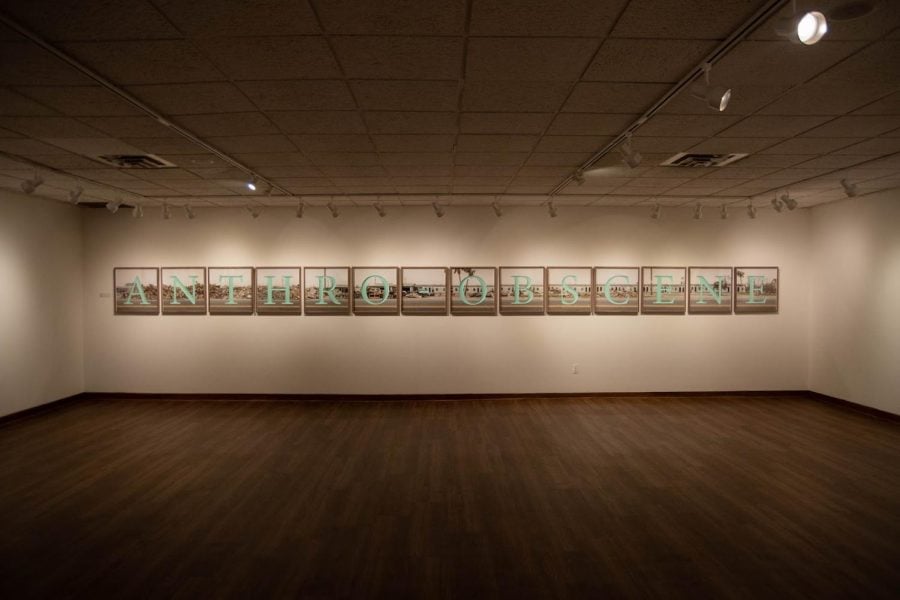“Anthro-obscene” exhibition explores climate change data, human impact
Tyler Keim/The Daily Northwestern
One of the pieces in artist Stefan Petranek’s exhibition at the Dittmar Gallery titled “In Our Hands.”
November 17, 2021
The wreckage of homes lies littered on a desolate highway. Tall piles of wood and broken concrete obscure a stormy grey sky. Palm trees curl over from high winds.
This is the landscape artist Stefan Petranek captures in a 14-panel photography display exposing Hurricane Michael’s destruction of Mexico Beach, Fla., in 2018. On the back wall, hollowed into each photo frame is a letter lined with turquoise foam to spell out “ANTHRO-OBSCENE,” the namesake of Petranek’s exhibition at Dittmar Gallery.
“Anthro-obscene: What We Choose Not to See,” open to the public through Dec. 8, explores how anthropogenic — or human-generated — climate change alters natural landscapes. The exhibit includes a selection of work from “The Future is Broken,” which premiered in 2019 at Indiana University–Purdue University Indianapolis’ Herron School of Art and Design, where Petranek is an associate professor of photography and intermedia.
Motivated by a feeling of urgency, Petranek said he titled the exhibition “Anthro-obscene” as a “personal response” to the obscenity of a current lack of action on climate change, despite ample knowledge of it.
“My desire to speak for climate change specifically comes out of my own anxieties for thinking about the future,” Petranek said.
Before pursuing photography and interdisciplinary art full time, Petranek studied biology and worked within an environmental engineering company, familiarizing himself with climate policy.
Each piece of artwork in the exhibition is a photograph of a place that carries personal significance to Petranek, from Summer Lake, Ore., to the Upper Mississippi River, Minn. However, Petranek obscures the landscapes by overlaying climate science data exposing climate change’s impact on those areas.
In “In the Eye—Hurricane Michael, October 8, 2018,” Petranek uses a laser-etching technique to burn jagged lines representing ocean gyres into a photograph of his nephew wading in water near Mexico Beach.
This technique, which comes from Petranek’s experimentation with laser engravers in Herron’s digital fabrication lab spaces, enables him to precisely erode a photograph’s surface.
“It’s adding heat to this photographic landscape, and it’s changing it,” Petranek said. “Climate change is based around too much warming of the climate, and so in that way, it parallels the larger issue.”
Through data visualization strategies like laser etching, Petranek said he can expose what is happening to landscapes beyond what meets the eye.
“These landscapes often can look just fine and normal, and our capacity to understand how they’re changing is really limited with our own eyes,” Petranek said. “When we can start to comprehend or recognize how those spaces or those landscapes are going to be changed by climate change, we feel like we have a much closer connection to it and concern for it.”
Weinberg sophomore Eve Downing, a Dittmar student curator, said she hopes the exhibit sparks conversations between visitors, including Northwestern students experiencing climate anxiety.
Growing up in Southcentral Alaska, Downing said she has witnessed her own home environments change. In her area, spruce beetles have rapidly reproduced due to rising temperatures, leading to the mass infestation and loss of spruce tree populations.
“I think it’s really great to have someone who’s working out of the Midwest bring out an attempt to show what will likely happen in these areas,” Downing said. “It can be difficult at times to share what is happening in more remote areas.”
Earth and Planetary Sciences Prof. Daniel Horton said he finds it powerful when artists such as Petranek use aesthetic, emotional mediums to communicate the cold, hard facts of climate change.
Horton, who leads the University’s Climate Change Research Group, said there has not yet been enough accomplished to address climate change problems at hand.
“My job is to project the future and say what the consequences might be,” he said. “But society at large easily has the potential to change the projected outcomes. It just requires the courage of the individual and the courage of our leaders to make those changes.”
Reflecting on what he wants visitors to take away from “Anthro-obscene,” Petranek said he hopes people understand what losing places to which they feel connected will mean.
“I hope that people look at the work and feel a stronger need to really value the earth and the climate,” Petranek said of his landscape-focused work. “It’s in the subtlety that we pull some of the most profound understandings of our environments.”
Email: jorjasiemons2024@u.northwestern.edu
Twitter: @JorjaSiemons
Related Stories:
— One Book One Northwestern photo contest winners focus their lenses on climate change
— Captured: Vertigo premieres student-written play with messages of climate change and inclusion
— Climate change could have drastic consequences in Illinois, report co-led by NU profs states



